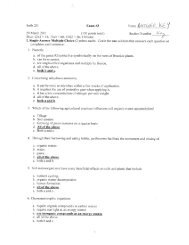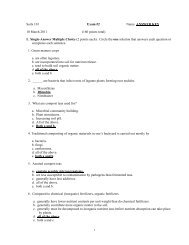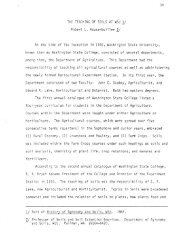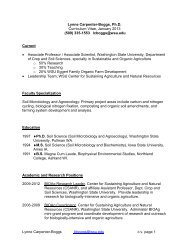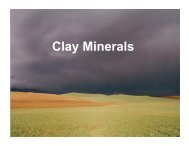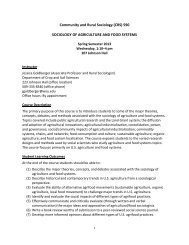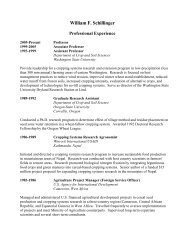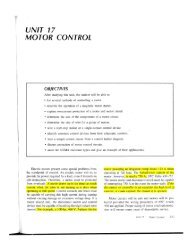2012 Dryland Field Day Abstracts - Dept. of Crop and Soil Sciences ...
2012 Dryland Field Day Abstracts - Dept. of Crop and Soil Sciences ...
2012 Dryland Field Day Abstracts - Dept. of Crop and Soil Sciences ...
Create successful ePaper yourself
Turn your PDF publications into a flip-book with our unique Google optimized e-Paper software.
Part 4. bioenergy cropping systems research Page 61<br />
Managing Feral Rye in Winter Canola through Herbicide Selection<br />
Frank Young 1 , Dennis Roe 2 , Larry McGrew 1 , Dale Whaley 2 , Chasity Watt 3<br />
1 USDA-ARS; 2 <strong>Dept</strong>. Of <strong>Crop</strong> <strong>and</strong> <strong>Soil</strong> <strong>Sciences</strong>, WSU; 3 Colville Confederated Tribes<br />
A preliminary herbicide efficacy study for the management <strong>of</strong> feral rye in winter canola was initiated in the spring <strong>of</strong> 2011. Our<br />
objective is to evaluate herbicides to improve the quality <strong>of</strong> subsequent winter wheat crops <strong>and</strong> prevent herbicide resistance in<br />
weeds. Select (clethodim), Assure II (quizal<strong>of</strong>op), <strong>and</strong> Roundup (glyphosate) were applied early spring. Because winter canola<br />
plants had canopy closure in the fall <strong>of</strong> 2010, feral rye was sprayed only in the spring. Final feral rye control in mid-May was 74%,<br />
64%, <strong>and</strong> 99% for Assure II, Select Max, <strong>and</strong> Roundup, respectively (see table). Feral rye biomass <strong>and</strong> head counts responded<br />
similarly within each herbicide treatment. In the plots treated with Roundup no seed heads were produced, <strong>and</strong> Assure II treated<br />
plots resulted in only three feral rye seed heads/yd 2 . This is in sharp contrast to 255 feral rye heads/yd 2 produced in the untreated<br />
plots. Winter canola yield increased 40% to 48% compared to the untreated check depending on the herbicide treatment.<br />
Effect <strong>of</strong> grass herbicides on feral rye control, biomass, seed heads, <strong>and</strong> winter canola yield. a<br />
Herbicide Control Rye Biomass Heads Yield<br />
Additional plots we established last fall (2011) in a<br />
severe, natural infestation <strong>of</strong> rye in Douglas Co.<br />
Assure II, Select 2EC, <strong>and</strong> Roundup were applied to<br />
CP115 winter canola (glyphosate tolerant) on<br />
October 16, 2011. Three weeks later control <strong>of</strong> the<br />
initial severe feral rye population with Roundup was<br />
excellent; however controlling this population<br />
opened up the canopy <strong>and</strong> a new flush <strong>of</strong> feral<br />
emerged. This new flush <strong>of</strong> rye was not occurring in<br />
the untreated or other two herbicide treated plots<br />
because feral rye ground cover was complete in<br />
these treatments. Assure II <strong>and</strong> Select 2EC stunted<br />
the feral rye considerably.<br />
% lbs/A<br />
no yd -2<br />
A Change is in the Air: Refining Canola Fertilizer Recommendations<br />
Bill Pan, Ashley Hammac, Tai McClellan, Meagan Hughes, John Rumph, Ron Bolton, <strong>and</strong> Rich Koenig<br />
<strong>Dept</strong>. <strong>of</strong> <strong>Crop</strong> <strong>and</strong> <strong>Soil</strong> <strong>Sciences</strong>, WSU<br />
Current nitrogen (N) recommendations for canola are widely variable. Our objective is to develop nutrient (primarily N <strong>and</strong> sulfur)<br />
recommendations for major oilseed crops that maximize oil yield <strong>and</strong> quality. We initiated a N x sulfur (S) experiment in 2007 at<br />
the Wilke Farm near Davenport <strong>and</strong> the Palouse Conservation <strong>Field</strong> Station (PCFS) near Pullman that includes a range <strong>of</strong> N rates (0<br />
lbs/A<br />
Untreated 0 3,920 255 1,165<br />
Assure II 74 823 3 1,635<br />
Select Max 64 1,597 40 1,680<br />
Roundup 99 290 0 1,730<br />
a Biomass <strong>and</strong> head counts recorded June 1, 2011. Control recorded on May 16, 2011.<br />
Untreated Treated with<br />
glyphosate<br />
Feral rye at Okanogan <strong>and</strong> Bridgeport was controlled with glyphosate.




